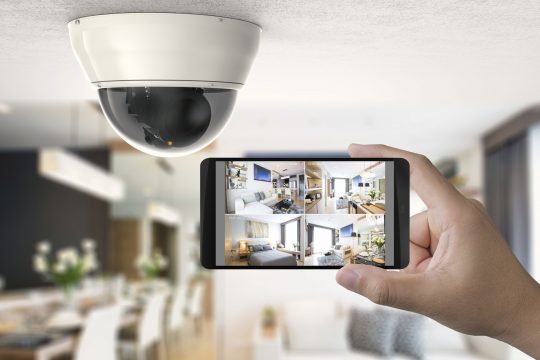Thinking about cameras in your home or small business? Here are six tips to remember for a successful installation.
If you’re looking to install or upgrade your home surveillance system, you should be aware of a few crucial areas: the key functions of your cameras, local privacy regulations, cyber security requirements and other installation factors. Whether it’s security for a residential or commercial space, it’s important to keep these six considerations in mind.
Camera placement is key
When it comes to camera installation, knowing where to install a device is key. Outside the home, it’s important to ensure every entrance point is covered. The cameras should be facing entry points, so you’re able to see anyone who enters your property. People often install their devices too far away, or right next to the entrance point. While you’ll still catch people walking by, the camera won’t be able to get a full-face view – which is really what is needed in order to capture the best image possible.
Rules of thumb on indoor camera placement depend on what you intend on using the cameras for and the comfort levels of the occupants. If indoor cameras are used to protect a certain asset, such as electronics or expensive household goods, the cameras should be pointing directly at those assets. However, keep in mind that some aren’t comfortable with cameras installed within the home, so it’s wise to be mindful of the objective for indoor security and determine if it’s actually necessary.
Be aware of placing cameras in compromising locations
Users should also think carefully about placing cameras anywhere that inhabitants might be compromised. Locations such as bedrooms, bathrooms or any other areas where people may not realize they’re being recorded should be avoided. Also, be aware of where your outdoor cameras are pointed. For example, it’s important that the camera’s field of view is looking only at your property, rather than your neighbor’s, which could lead to concerns or violations of privacy.
Security camera owners need to be aware of privacy regulations
Particularly with regard to residential security cameras, it’s very important to learn what your local regulations are, as they differ from one municipality to the next. One good way to declare the existence of your system is a sign stating your property is under surveillance. This will let a visitor know that by entering your property, they are consenting to being recorded. Postings are legally required in some places, so it’s a smart decision to have one even if it’s not a regulation. It’s also a good idea to consult with your neighbors so they are aware of the system and what it is actually recording.
People often use cameras as a prevention tool, so indicating a recording is in progress can reduce the likelihood of an intrusion. If people don’t know they’re being recorded, the presence of cameras is unlikely to prevent a crime.
Take steps to ensure your network is cyber secure
If your camera installation is at your home, any Internet-enabled devices used for security and surveillance should operate on a separate network from regular home web use. This segmentation will add an extra layer of security; in the event something does happen on the home use side of the network, the network supporting your security system will remain uncompromised. It’s also important to know when software updates are available, so items downloaded from the Internet can be monitored for anything harmful.
Open standards are an important security camera function
Aside from video and audio quality, when it comes to the useful functions of security cameras, open standards are high on the list. Open standards allow cameras to connect to any Video Management System (VMS) they want, seamlessly, through a common interface, such as the one provided by ONVIF. It can be helpful to think of smart home systems like Z-Wave or Zigbee, which allow many different devices to work together, when thinking about security. It’s very similar for security cameras, where open standards provide end users with the flexibility to choose different cameras, when replacing or updating their camera system.
Security cameras have a variety of uses
Safety and security aside, it’s important to also recognize the other ways a camera system could enhance your home or business. Cameras have many uses, besides security. In essence, it’s a sensor that generates data, which can be anything from information and video of packages being delivered, or when kids arrive home from school. More than just a security measure, cameras can help keep track of schedules, and using analytics, can let users know of any anomalies.
When choosing a camera system, users must determine their main objectives for installing security cameras. Taking these six considerations into account will help with the decision making process.






